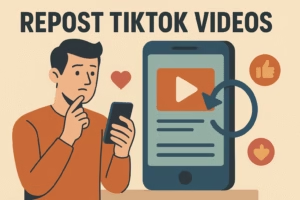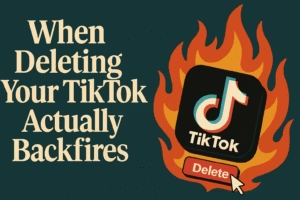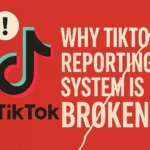It’s the creator’s version of a panic button:
Your video is tanking. It’s been 2 hours, and you’re still stuck at 230 views. You squint at your thumbnail. Was it the hook? The upload time? The hashtags?

Suddenly, you’re hovering over the delete button, wondering if you should pull the plug and repost it later. Everyone has an opinion. Some say deleting hurts your account. Others swear reposting gave them a viral hit.
So who’s right?
Let’s unpack the chaos, myths, and surprisingly useful strategies behind TikTok’s most debated move: delete or repost TikTok Videos.
TL;DR: Should You Delete and Repost?
-
Don’t delete unless you’ve changed something — repost with a new hook, title, or edit.
-
Avoid repeating exact uploads — TikTok may flag you as spammy.
-
Privating isn’t always safe — it can still reduce your reach long-term.
-
Reposting works when you fix a thumbnail, caption, or post at better times.
-
Instead of deleting, build multiple versions of your idea upfront.
Need help editing your videos fast or scheduling smarter? Tools like Blaze AI can repurpose, re-edit, and batch schedule across platforms without burning you out.
Why Some Creators Swear by; Repost TikTok Videos (and Have the Numbers to Prove It)
Let’s be honest: some TikTok creators do get better results the second time around. There are countless stories floating around Reddit, Discord servers, and TikTok DMs that go something like this: “I posted a video, it flopped, I deleted it, changed a few things, reposted it — and boom, 70K views.”
Sounds magical, right?
But let’s dissect what’s really going on. Most of these creators aren’t just reuploading the exact same file. They’re tweaking things:
-
Changing the opening 3 seconds (aka the “hook”)
-
Posting at a more optimized time
-
Updating the caption or hashtags
-
Re-editing the pacing or music
-
Using a different thumbnail frame
What you’re seeing isn’t a true “repost.” It’s a new version of the same idea — and TikTok treats it as such.
And that’s the part most people miss: TikTok doesn’t punish second attempts. It punishes lazy duplication. If you copy-paste the same file without any edits, it might be ignored or even flagged as spam, especially if the original performed poorly.
But if you present a new take — even slightly — TikTok gives it a fresh shot.
In fact, many seasoned creators now plan to repost each video twice. They treat the first upload as a test, then use the second one to optimize for reach. It’s not shady. It’s strategic.
So if you’ve got a video you know is strong but feel the algorithm missed it, here’s your green light: repost it — but evolve it.
When Deleting Your TikTok Actually Backfires

Now here’s the darker side of this conversation. Because for every success story, there’s someone who quietly nuked their reach — and they don’t even know it.
Deleting a TikTok can hurt your account if you:
-
Do it too frequently
-
Repost without making changes
-
Delete high-performing videos (even with minor flaws)
-
Use the delete button as a crutch instead of learning from analytics
TikTok’s algorithm tracks behavior. If you constantly pull your videos down within hours, it signals volatility. That tells the system you’re not confident in your content or consistent in your niche. And that’s a red flag.
Also, deleting a video erases its entire performance record. If it had slow growth that might’ve picked up later (which does happen), you’ve killed the momentum before it even started.
There’s another trap: some creators think switching a video from public to private is safer. But recent discussions suggest even privating videos can reduce your future reach — especially if you do it often. It’s not an official TikTok rule, but countless creators report drops after heavy use of the private feature.
Bottom line? Don’t treat your video feed like a scratchpad. TikTok is watching your patterns. If you’re constantly deleting and re-uploading like a gambler chasing wins, you’re training the algorithm to throttle your reach.
Be intentional. If you repost, make it count. Don’t repost just because you hoped it would go viral. Repost because you learned something and have a better version.
What You Should Do Instead (If a Video Flops)

Let’s say you posted a TikTok you’re proud of. It’s clever. It’s edited well. The hook is strong. But after 24 hours? Crickets. Maybe 200 views. Maybe 20.
Now what?
Here’s what you don’t do: panic-delete it.
Here’s what smart creators do instead:
1. Analyze the Hook
Did you grab attention in the first 1–3 seconds? If not, there’s your answer. TikTok doesn’t give you 10 seconds to “warm up” — it scans user drop-off rates almost instantly. If people are scrolling past before the payoff, the algorithm won’t keep testing it.
Fix: clip your best moment to the very beginning. Start with a punchline, a face, a question, or movement.
2. Check Your Watch Time
Low watch time = death. If your average view duration is under 50%, TikTok assumes the content isn’t sticky.
Fix: try faster cuts, less fluff, or restructure the story. Attention span is currency — respect it.
3. Change the Caption and Hashtags
If you wrote your caption like a tweet, you missed the point. TikTok’s captions and hashtags aren’t for wittiness. They help train the algorithm.
Fix: include the main keyword people would search for to find your video. Use a mix of broad and niche hashtags.
4. Look at Post Timing
Did you post at 3AM? When your core audience is offline? Timing matters more than people think, especially if your followers live in a single region.
Fix: test your next upload during high engagement periods — usually between 11AM–2PM or 6PM–9PM local time.
Once you’ve adjusted all this? Repost it.
Don’t delete the original right away. Just repost the new version and compare. If the new one takes off, you can always archive the old one later. Or keep both and let the platform decide which deserves the spotlight.
The Algorithm Has a Memory (And It’s Smarter Than You Think)
Here’s the part the “just repost it” crowd often misses:
TikTok doesn’t just analyze videos — it tracks user behavior across the board. Your account builds a fingerprint over time based on:
-
How often you post
-
How quickly you delete
-
Whether you use repetitive hooks or audio
-
How long users engage with your full feed
-
What type of viewers your videos attract
This means that if you’re frequently yanking underperforming videos, TikTok learns to devalue your next few uploads. Why? Because its systems think you don’t believe in your own content.
It’s not personal. It’s machine logic.
Also, re-uploading the same video file — same length, same cuts, same audio — can trigger the system to treat it like duplicate content. That’s not a myth. There’s evidence that TikTok has internal spam filters to prevent mass re-posting behavior, especially from people trying to “game” the feed.
Creators who succeed long-term don’t keep deleting and hoping. They build iterations. They treat content like software updates. Version 1.0 didn’t hit? Cool — time for version 1.1 with a new title, hook, and runtime.
That’s how you win.
The Better Strategy: Iterate Like a Creator, Not a Quitter
The most successful creators aren’t lucky. They’re iterative. They test. They tweak. They relaunch — not the same video, but a smarter version of it.
Instead of deleting a flopped post, ask:
-
Can I restructure the first 3 seconds?
-
Can I shorten or punch up the middle?
-
Would a new caption get more curiosity clicks?
-
Can I change the audio or replace it with a trending sound?
Even better — pull quotes or one-liners from your original video and turn them into micro-content. That same “dead” post can give birth to three new ones.
Think like a studio, not an influencer.
Studios don’t cancel a show after one bad episode. They rework the formula, tighten the script, keep what works, cut what doesn’t.
Apply that to your content. You’ll stop feeling like you’re guessing and start building with intent.
Final Take: Don’t Just Repost. Rebuild.
Deleting and reposting can work — but not because of some algorithm glitch. It works when you treat it like a revision, not a redo.
Just reposting out of frustration is like submitting the same failed test twice and expecting an A.
If you really believe in a video? Revise it. Tweak the delivery. Change the intro. Try a new thumbnail or structure.
But don’t obsess over one video’s failure. Obsess over the system you’re building behind it.
TikTok’s memory is short — but yours should be long.
Your next viral isn’t a miracle. It’s the 8th version of a video you refused to give up on.


